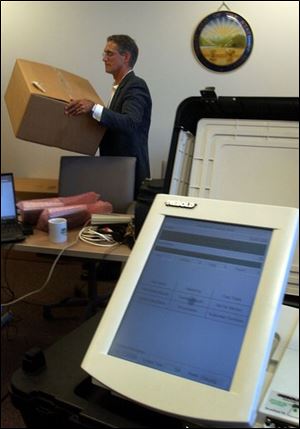
Elections board gets new voting machines
7/17/2003
Joe Nista unpacks the new electronic voting machines at the county Board of Elections office in Government Center.
The first of hundreds of new voting machines arrived at the Lucas County Board of Elections office yesterday, as the county brings its voting systems into the computer age.
Six demonstration units - three touch screen voting machines and three that use optical scan technology - will be used to teach elections workers and the voting public how to use them to vote.
A total of 445 more are expected by the end of the month.
“My goal is that there will be no voter in Lucas County who will be able to say `I didn't have a chance to see it' before Election Day,” said Joe Kidd, director of the county elections board. “People are going to be exposed to it so they aren't afraid of it.”
Training began almost immediately yesterday, as elections office staffers learned about the machines. Volunteers with the Toledo-Lucas County League of Women Voters also are expected to be trained.
The league is one of what Mr. Kidd said he hopes are several local community groups to help teach voters how to use the machines.
“We're lining up various public places for locations for demonstrations,” Mr. Kidd said, including malls, grocery stores, library branches, union halls, and large companies.
The machines, manufactured by Diebold Elections Systems of North Canton, Ohio, are on lease to the county as part of an agreement to help the county with elections through the March, 2004, presidential primary election. The first election in which the machines will be used is Toledo's September primary.
A special election in August, which includes a key levy renewal for Toledo Public Schools, among other things, will be conducted using old-fashioned paper ballots.
The county's 225 voting locations, each of which contains between two and four precincts, will get one touch-screen and one optical scan tabulating machine apiece, Mr. Kidd said. Voters will be able to vote on either machine.
“You may have to wait in line for the touch-screen machines, true,” Mr. Kidd said. “But if you want to vote quickly and leave quickly, you can vote an optical scan ballot.”
At each precinct, up to three people will be able to complete optical scan ballots in separate booths at the same time.
After making their selections, voters will insert their ballots into the tabulation machine, which will keep a count of the votes and then deposit the ballot into a secure container, said Jessica Hiner, a project manager for Diebold who set up the machines at Government Center yesterday.
The touch-screen and optical scan systems both retain votes three different ways - with a flash memory built into the electronic machines, on a removable memory card, and on paper printouts. Once polls close, results can be sent to elections headquarters either electronically by telephone modem connection or by ground transport, she said.